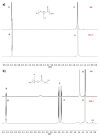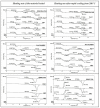Forensic Engineering of Advanced Polymeric Materials-Part VII: Degradation of Biopolymer Welded Joints
- PMID: 32438761
- PMCID: PMC7284890
- DOI: 10.3390/polym12051167
Forensic Engineering of Advanced Polymeric Materials-Part VII: Degradation of Biopolymer Welded Joints
Abstract
Welding technology may be considered as a promising processing method for the formation of packaging products from biopolymers. However, the welding processes used can change the properties of the polymer materials, especially in the region of the weld. In this contribution, the impact of the welding process on the structure and properties of biopolymer welds and their ability to undergo hydrolytic degradation will be discussed. Samples for the study were made from polylactide (PLA) and poly(3-hydroxyalkanoate) (PHA) biopolymers which were welded using two methods: ultrasonic and heated tool welding. Differential scanning calorimetry (DSC) analysis showed slight changes in the thermal properties of the samples resulting from the processing and welding method used. The results of hydrolytic degradation indicated that welds of selected biopolymers started to degrade faster than unwelded parts of the samples. The structure of degradation products at the molecular level was confirmed using mass spectrometry. It was found that hydrolysis of the PLA and PHA welds occurs via the random ester bond cleavage and leads to the formation of PLA and PHA oligomers terminated by hydroxyl and carboxyl end groups, similarly to as previously observed for unwelded PLA and PHA-based materials.
Keywords: biopolyesters; differential scanning calorimetry (DSC); electrospray ionization mass spectrometry (ESI-MS); hydrolytic degradation; poly(3-hydroxyalkanoate) (PHA); polyester welded joints; polylactide (PLA).
Conflict of interest statement
The authors declare no conflict of interest.
Figures









Similar articles
-
Development of Polyhydroxybutyrate-Based Packaging Films and Methods to Their Ultrasonic Welding.Materials (Basel). 2023 Oct 10;16(20):6617. doi: 10.3390/ma16206617. Materials (Basel). 2023. PMID: 37895599 Free PMC article.
-
Forensic engineering of advanced polymeric materials. Part III - Biodegradation of thermoformed rigid PLA packaging under industrial composting conditions.Waste Manag. 2016 Jun;52:69-76. doi: 10.1016/j.wasman.2016.04.016. Epub 2016 Apr 18. Waste Manag. 2016. PMID: 27103398
-
Thermal Welding by the Third Phase Between Polymers: A Review for Ultrasonic Weld Technology Developments.Polymers (Basel). 2020 Mar 31;12(4):759. doi: 10.3390/polym12040759. Polymers (Basel). 2020. PMID: 32244471 Free PMC article. Review.
-
Mechanical Performance and Microstructural Evolution of Rotary Friction Welding of Acrylonitrile Butadiene Styrene and Polycarbonate Rods.Materials (Basel). 2023 Apr 22;16(9):3295. doi: 10.3390/ma16093295. Materials (Basel). 2023. PMID: 37176175 Free PMC article.
-
A State of the Art Review of Fillet Welded Joints.Materials (Basel). 2022 Dec 7;15(24):8743. doi: 10.3390/ma15248743. Materials (Basel). 2022. PMID: 36556549 Free PMC article. Review.
Cited by
-
Bioplastics: A new analytical challenge.Front Chem. 2022 Sep 23;10:971792. doi: 10.3389/fchem.2022.971792. eCollection 2022. Front Chem. 2022. PMID: 36212056 Free PMC article. Review.
-
Structure-Morphology-Antimicrobial and Antiviral Activity Relationship in Silver-Containing Nanocomposites Based on Polylactide.Molecules. 2022 Jun 11;27(12):3769. doi: 10.3390/molecules27123769. Molecules. 2022. PMID: 35744897 Free PMC article.
References
-
- Mangaraj S., Yadav A., Bal L.M., Dash S.K., Mahanti N.K. Application of biodegradable polymers in food packaging industry: A comprehensive review. J. Packag. Technol. Res. 2019;3:77–96. doi: 10.1007/s41783-018-0049-y. - DOI
-
- Sam S.T., Nuradibah M.A., Chin K.M., Hani N. Current application and challenges on packaging industry based on natural polymer blending. In: Olatunji O., editor. Natural Polymers: Industry Techniques and Applications. Springer; Cham, Switzerland: 2016. pp. 163–185.
-
- Ahmed J., Varshney S. Polylactides-chemistry, properties and green packaging technology: A review. Int. J. Food Prop. 2011;14:37–58. doi: 10.1080/10942910903125284. - DOI
-
- Lemoigne M. Products of dehydration and of polymerization of β-hydroxybutyric acid. Bull. Soc. Chem. Biol. 1926;8:770–782.
Grants and funding
LinkOut - more resources
Full Text Sources

